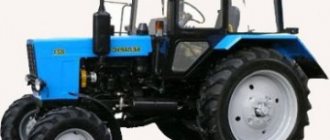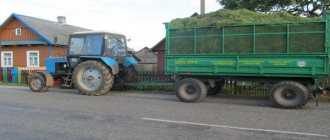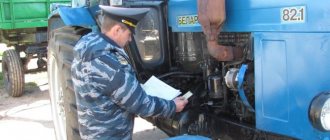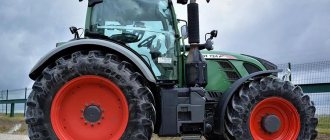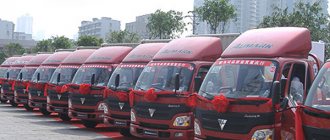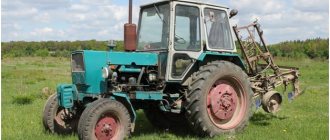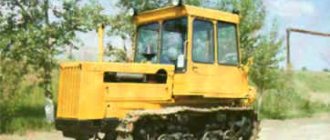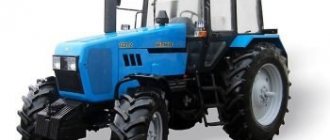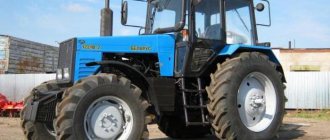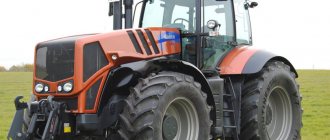The universal wheeled tractor with a diesel engine MTZ-2, designed at the Minsk Tractor Plant, became the first-born in the famous Belarusian family. The tractor was designed for processing row crops. The main innovation of the model is the hydraulic attachment system, which makes it possible to work without a trailer.
This kind of machine was first created in the USSR. The MTZ-2 design was specially adapted for inter-row cultivation of low-stem crops (cabbage, sugar beets, onions, etc.) - the front and rear wheels of the tractor followed each other.
We can safely say that MTZ-2 occupied an important place in the history of industrial development of the USSR, and now Belarus. Until now, the Minsk Tractor Plant continues to successfully produce modern models of tractors and other agricultural machinery under the BELARUS brand.
Tractor "KD-35"
0
Source:
See all photos in the gallery
November 4, 1950 was noted in the chronicle of the labor exploits of Belarusian tractor builders as the day the serial production of KD-35 tractors began. The first-born of Minsk tractor builders enjoyed great and well-deserved success among field workers. The KD-35 tractors were equipped with 4-cylinder diesel engines producing 37 hp. the engine was distinguished by significant efficiency. Thus, for one hectare of plowing under average conditions, it consumed 13 kg of fuel. The tractor's fuel tank contained fuel for 10 hours of uninterrupted operation. Prototypes of the machine plowed up to 6 hectares of land in 10 hours. The tractor was not produced by the plant for long, only 9 months, until August 1951. During this time, 406 cars rolled off the assembly line. The production of diesel and starting engines for the KD-35 at the plant did not stop. They were supplied to the Lipetsk Tractor Plant. Subsequently, this engine was used on a wheeled universal row-crop tractor, on which factory designers had been working since 1948.
Minsk models of small-scale mechanization
The MTZ tractor should include in this category:
- model 100;
- model 132 (modification 132 N);
- model 142;
- model 152.
Despite their small overall dimensions, the models are endowed with the following quality characteristics, namely: maneuverability, low maintenance and ease of operation. All of the above models can also be used with trailers and mounted agricultural equipment. The scope of use of models is diverse; they are in demand in various sectors of agriculture and livestock farming, and in private farming.
Main technical characteristics of MTZ 100
The MTZ 100 model is a universal power unit, which is located between the first and second traction classes. Main technical indicators:
- power 100 l. With;
- specific diesel fuel consumption 242 g/kW h;
- fuel tank volume 156 l;
- weight 3750 kg.
The model has a rear linkage, which maximizes the functionality of the tractor.
The MTZ model 102 tractor is designed to work with mounted, trailed and semi-mounted equipment. This fact indicates that this is a multifunctional model, which is in great demand in the national economy today.
Main technical parameters:
- power 105 l. With;
- front clearance 645 mm;
- cylinder volume 4.75 l.
When asked how many engine hours to change the oil, you should look for the answer in the manufacturer’s instructions. If the regime is violated, the main elements of the tractor may fail.
MTZ-1 and MTZ-2
0
Source:
The Belarus universal wheeled tractor was designed to work with mounted, semi-mounted and trailed agricultural machines. The design of the tractor was made in two modifications: MTZ-2 - for inter-row cultivation of low-stem crops with matching tracks of the front and rear wheels and MTZ-1 - for processing high-stem crops with close front wheels. The tractor was designed to operate on two wheels: low-pressure rubber cylinders and wheels with a rigid steel rim with spurs. The tractor had an independent power take-off shaft drive, a hydraulic system for lifting mounted implements, and was equipped with a removable adjustable tow hitch. July 18, 1949 became a significant day for all tractor manufacturers. The first Belarusian factory-designed wheeled tractor emerged from the gates of the experimental workshop. A prototype of a wheeled tractor subsequently became the basis for the creation of the MTZ-2 serial machine. In 1949, 7 prototypes were produced and underwent lengthy factory tests. A historical date for the plant’s staff was 1953, when on October 14, the assembly of the MTZ-1 and MTZ-2 tractors, created by the plant’s designers, was completed on the main conveyor. These machines determined the entire further specialization of the plant in the production of wheeled universal row-crop tractors.
×
0
Source:
Firstborn
The honor of assembling the first MTZ-2 fell to the replacement of master A. Malitsky. Fitters-assemblers V.A. Chayuk, M.T. Merkul assembled the rear axle. The engine, half-frame, and clutch housing were delivered to the conveyor. Fitters-assemblers A. V. Raschinsky, D. P. Shevtsov, N. R. Ostrovsky, E. Vch Nekhai, I. M. Vasiliev, P. I. Gornostaev worked on No. 1 “Belarus”.
By the end of the working day on October 14, 1953, workers, foremen, designers, technologists and plant employees gathered at the main conveyor of tractor assembly shop No. 2. The first MTZ-2 tractor rolled off the main assembly line in a solemn ceremony. The best tractor driver of the experimental workshop, former front-line soldier N.D. Velichkin, driving the car, smoothly lowered it from the assembly line, made a hundred-meter circle around the building and stopped at an improvised podium. The rally began.
KT-12 and KT-12A
0
Source:
In the spring of 1951, the MTZ team received a very important government task - to master the production of skidders, which were in great demand in the logging industry. The KT-12 gas generator tractor is a special tracked vehicle designed for forest skidding. It appeared in the USSR in the first post-war years. There were no analogues to it in any country in the world. Previously, skidding was carried out by horse-drawn vehicles, manual or mechanical winches. The KT-12 tractor was created by designers of the Kirov plant in Leningrad in collaboration with scientists from the Leningrad Forestry Academy. The KT-12 tractor was produced at the Kirov plant until 1951. Now it was necessary to establish its production at the Minsk Tractor Plant. Only three months were allotted to resolve all organizational issues. So, in the short history of its existence, MTZ had to develop a second (after the KD-35) machine, and, moreover, not of its own design. On August 15, 1951, the first batch of KT-12 skidding machines rolled off the main conveyor of the tractor assembly shop. During the production process, the tractor underwent modernization aimed at improving the performance of the machine. In a short period of time, factory designers, by changing a number of components and parts, increased the warranty period of the machine by 1.5 times.
TDT-40
0
Source:
In the early 50s, the USSR Ministry of Forestry Industry stated that the KT-12A with its gas generator installation did not meet the increased requirements. Considering the disadvantages of the tractor, the ministry decided to abandon this machine altogether and raised the question of creating a new, more reliable skidder with a power of 60 hp instead. Having analyzed the situation, the designers and management of MTZ recognized the feasibility of creating a more powerful skidder, but also expressed the opinion that one powerful class of tractor for all zones in all forestry operations would be uneconomical. It was necessary to design a medium-power skidder that could be created on the basis of the KT-12A by installing a diesel engine of a Belarus wheeled tractor on it. In 1954, they developed the design of such a tractor, giving it the brand TDT-40. The tractor was intended for transporting logs directly from the cutting area. In addition to timber skidding, it was indispensable in logging and in all kinds of transport work in off-road conditions. Based on the results of operational tests in 1955, the interdepartmental commission stated that the TDT-40 tractor was very necessary for the USSR Ministry of Forestry Industry and it was advisable to establish its production in a short time. By decision of the USSR Ministry of Tractor and Agricultural Engineering, serial production of TDT-40 diesel tractors began at MTZ in May 1956. By the end of the year, their number reached 3,430. In the same year, design work was completed and the first experimental D-50 diesel engines for the promising tractor were manufactured. The new engine exceeded the power of its predecessor by 10 hp, was smaller in size and 350 kg lighter.
TDT-54 and TDT -60
0
Source:
To work in the forests of the Urals, Siberia and the Far East, more powerful skidders were required than the TDT-40. The Ministry of Automotive Industry instructed the designers of the Minsk Tractor Plant to develop a project for such a tractor in conjunction with the Scientific Research Autotractor Institute (NATI) according to the technical requirements of the Ministry of Forestry Industry of the USSR. Initially, the tractor was given the brand TDT-54. To increase productivity, a D-54 diesel engine with a power of 54 hp was used. tractor DT-54 of the Kharkov Tractor Plant. After the skidder TDT-54 received the go-ahead from the state commission for mass production, a detailed analysis of each unit was carried out. As a result, it was decided to modernize most of its components. In addition, the D-54 diesel engine was boosted to 60 hp. and as a result, the tractor received a new name TDT-60. In 1956, four of its prototypes passed all control state tests under production conditions at the Vakhtansky timber industry enterprise in the Gorky region. The simultaneous production of two tractors, MTZ-2 and TDT-40, completely different in design and purpose, put the plant in a difficult position. The plant did not have the opportunity to simultaneously develop two different productions: the production of the MTZ-2 tractor, which was extremely necessary for agriculture, and the TDT-40 tractor, in which the USSR Ministry of Forestry Industry was interested. Technical and economic calculations showed that the Minsk Plant needs to specialize in the production of wheeled universal row-crop agricultural tractors. The management of the plant submitted a proposal to the ministry - to stop production of the TDT-40 tractor at MTZ, transferring it to the plant in Karelia, and the developed TDT-60 model to the Altai Tractor Plant. By decree of the USSR government of January 30, 1956, the Onega Machine-Building Plant in Petrozavodsk was transferred to the Ministry of Tractor and Agricultural Engineering of the USSR for the production of TDT-40 tractors. Before that, it was under the jurisdiction of the USSR Ministry of Forestry Industry. In 1957, without stopping the production of TDT-40 at MTZ, the development of the tractor began at the Onega Tractor Plant. In total, until 1958, MTZ produced 12,977 TDT-40 tractors. In 1957, the TDT-60 tractor was put into serial production at the Altai Tractor Plant. This was the end of the history of skidders at MTZ, where for 7 years they were produced in parallel with wheeled ones.
Links
Wheeled universal self-propelled chassis DSSH-14 • DVSSH-16 • T-16 • SSH-28 Crawler agricultural Communar • SHTZ-NATI • KhTZ-T2G • S-60 • SG-60 • S-65 • SG-65 • S-80 • KD-35 • T-38 • DT-54 • DT-55 • DT-56 • DT-57 • DT-60 • GB-58 • T-54 • T-70 • T-75 • T-74 • DT-75 • T-4A • T-100MGS • T-150 • DT-175 Tracked industrial S-100 • T-108 • T-100 • T-130 • T-140 • D-804 • T-170 • T-180 • T-200 • DET-250 • T-220 • T-330 • T- 500 • T-800 Skidding KT-12 • TDT-40 • TDT-55 • TDT-60 • TDT-75 • TT-4 • TST-130 • LT-157 Army STZ-5 “Stalinets” • T-154 • MoAZ-541 50 hp Belarus-510 · Belarus-512
60 hp Belarus-592 · Belarus-570
Belarus
-572
Belarus
-520
Belarus
-52280 hp Belarus-80.1 · Belarus-82.1
Belarus
-90
Belarus
-92
Belarus
-826
Belarus
-92090 hp Belarus-892 · Belarus-921
Belarus
-922
Belarus
-923
Belarus
-952105 hp Belarus-1021 · Belarus-1025
120 hp Belarus-1220 130 hp Belarus-1221 · Belarus-1222
150 hp Belarus-1523 210 hp Belarus-2022 300 hp Belarus-3022DC.1 Special tractors Cotton Belarus-80X · Belarus-100X
Rice Belarus-920R Horticultural Belarus-921.3 · Belarus-921.4-10/91
Special equipment Forestry equipment Belarus TTR-401M · Belarus ML-131
Belarus
MLPT-354M1
Belarus
MPT-461.1
Belarus
-
L82.2 Belarus MR-40/-01 Belarus
MR
-
25
/-02
Belarus TTR-
411
Belarus
L1221 Belarus
1221MPR
OPL Belarus PK-12
Belarus
TTR-411.1
Belarus L1221.1
Belarus MR
-25-01/-03Municipal vehicles Belarus 320MK · Belarus 320P04
Belarus
320MUP
Belarus 82MK
Belarus EP
-491
Belarus
MUP-750Mining equipment Belarus MPL-373M · Belarus MGL-363M
Belarus
MT-353M2
Belarus
MP-403M
Belarus MMP- 393MTracked tractors Belarus-2103 · Belarus-1502
Belarus
-1502-01Small-sized equipment Mini tractors and walk-behind tractors Belarus-05 · Belarus-09N
·
Belarus-132NMinsk Tractor Plant
MTZ-5
0
Source:
Time passed, and with it the requirements for the manufactured MTZ-2 tractor grew. It had a low transport speed (13 km/h) and an insufficient number of gears. The tractor began to lag behind in terms of fuel efficiency and material consumption. It was necessary to increase the reliability and service life of the machine. Having summarized the experience of operating MTZ-2 tractors, taking into account the state and level of tractor manufacturing, the plant’s design team in 1955-1956. carried out work on a radical modernization of the machine. This made it possible not only to eliminate existing shortcomings, but also to expand the scope of application of the machine and improve technical and economic indicators. This is how new models of the Belarus tractor appeared: MTZ-5 (1956 model). MTZ-5M and MTZ-5L (samples of 1957). MTZ-5, possessing great versatility, had an independent power take-off shaft drive, a more powerful and economical engine, and a hydraulic linkage system with remote cylinders.
The power of motivation
However, mass production of the new car still had to be established. Going to serial production and quickly using all the plant’s capacities was not at all easy. We must pay tribute to the powerful organizational skills of the plant director A. M. Tarasov, who managed to inspire the entire team and captivate the employees both in the ideological and material sense.
In particular, tractor manufacturers received over 8 thousand square meters. m of housing, designers and other employees were encouraged with bonuses. There was a competition among the workers to master the design standards; the craftsmen tried with all their might to ensure that the tractor assembly line worked at full capacity.
Here, for example, is one of the messages from the factory newspaper, typical of that time: “Turner Ivan Pashukevich, while trimming the end of the main balancer, processed 35 parts instead of 17 as ordered.”
To optimize production, new methods and technologies were introduced. For example, they began to use the electric spark method of hardening cutting tools and dies. Seven new installations increased tool life by 30-40%. Mechanical shop technologists came up with special devices for rounding gear teeth along a radius.
The designers have developed an independent drive to the power take-off shaft. This unit made it possible to fully ensure the execution of work with non-motorized machines. Engineers have created a design for remote cylinders designed to operate the tractor with sectional agricultural machines mounted on the sides of the tractor. In total, in 1954, young innovators made about 800 proposals, resulting in savings of 2.6 million rubles.
The result of hard work was not long in coming: at the end of October, the first trains from MTZ-2 left the railway platform of the plant for Ukraine, the RSFSR, Georgia, Latvia and Estonia. By the end of 1953, about 500 tractors were produced, and then the plant rapidly increased its pace. Thus, the enterprise has already fulfilled the plan for the first half of 1955 for gross output by 102%.
MTZ-5S
0
Source:
In 1959, after design improvements, production of the MTZ-5LS and MTZ-5MS tractors began. The letter “C” in the designation meant “high-speed”. Engine power was increased to 48 hp. (instead of 45) by increasing the speed to 1600 rpm (instead of 1500). The operating speed range was set within 5-10 km/h. The number of working gears in the gearbox was increased from four to five. Otherwise, there were no fundamental differences from the MTZ-5L and MTZ-5M tractors. Production of high-speed cars began in 1959.
Tractors that are efficient for forestry
Model 3522 Features:
- power 355 l. With;
- traction class 5;
- fuel tank volume 650 l.
Technical parameters of model 4522:
- power 431 l. With;
- fuel tank volume 650 l;
- operating weight 14785 kg.
Such powerful models can be used for work such as logging and stump uprooting.
In conclusion, we can conclude: the entire MTZ model range is distinguished by high build quality, each model can become universal. This is facilitated by the presence of front and rear trailing mechanisms on MTZ tractors.
MTZ-7
0
Source:
In 1958, the design was finalized, prototypes were made, tests were carried out, and drawings for the MTZ-7 all-terrain tractor with four driving wheels were issued in preparation for production. The first tractor design was developed using the front drive axle from the military all-terrain vehicle GAZ-67, did not have an adjustable track width of the front wheels and therefore did not provide for row-crop work. Due to the insufficient strength of the GAZ-67 bridge, the tractor did not pass the tests. The problem was solved after a GAZ-63 drive axle was installed on the tractor. The production of cabins for Belarus tractors began. The design of the removable cabin made it possible to use it on the tractor completely closed and in the form of an awning. With the use of such a cabin, the working conditions of the tractor driver have significantly improved.
Literature
- Belokon Ya. E., Okocha A. I., Shkarovsky G. V.
“Belarus” tractors of the MTZ and YuMZ families. Design, operation, maintenance. - Mn.: Ranok, 2003. - 260 p. — 10,000 copies. — ISBN 966-502-007-2. - Domestic agricultural tractors. An illustrated history of development over 100 years. - NATI. - M.: Vneshtorgizdat, 1996. - 54 p. — 1500 copies.
- Solovyov A. N.
[books.google.ru/books?id=pMuaBgAAQBAJ&dq Handbook of an engineer at an enterprise of technological transport and special equipment]. - In 2 volumes. - M.: Infra-Engineering, 2000. - T. 1. - 1344 p. — 2000 copies. — ISBN 978-5-9729-0023-7.
MTZ-50
0
Source:
Until 1959, MTZ had the capacity to produce only 18,000 wheeled tractors of the MTZ-2 type, 6,000 TDT-40 tracked skidders and 40,000 D-40 engines. Serial production of the MTZ-5, MTZ-5M, MTZ-5L tractors was still underway, work was carried out to modernize them, and in 1956 the designers basically designed a new diesel engine for the future MTZ-50 tractor. There was great interest in the creation of a new promising row-crop tractor not only at the plant, but also in the country. The technical design of the tractor was completed in 1957 and approved by the Main Scientific Automotive and Tractor Institute. In 1958, the experimental workshop produced several prototypes of the tractor. Based on the test results, the scientific and technical council of the VO "Soyuzselkhoztekhnika" recommended the wheeled universal row-crop tractor class 1.4 "Belarus" MTZ-50 for mass production. The MTZ-50 tractor was equipped with a 55 hp diesel engine, the weight of the machine was reduced by more than 400 kg. The tractor transmission was equipped with a 9-speed gearbox, providing a speed range ranging from 1.65 to 25 km/h.
Specifications
- MTZ-5 received a 40-horsepower engine, which is not very powerful.
- The operating weight of the equipment was 3.19 tons.
- The specific fuel consumption of the tractor was 200 g/hp. per hour with a fuel tank capacity of 90 liters. "Belarus-5" had a speed range of 1.4-22.3 km/h.
- The width of MTZ-5 was 1884 mm, length – 4095 mm, height – 2390 mm.
- Ground clearance was 450 mm under the rear axle, 650 mm under the rear wheels, 640 mm under the front axle.
MTZ-52
0
Source:
In 1959, based on the results of state tests, the design of the MTZ-50 tractor was finalized, the necessary documentation was issued and put into preparation for production. Based on the MTZ-50 tractor, a modification of the all-terrain tractor with four driving wheels, the MTZ-52, was developed. Due to lower slipping losses, the fuel efficiency of the MTZ-52 tractor is higher at all operating limits than the MTZ-50 tractor. On November 14, 1959, the Council of Ministers of the USSR issued a resolution “On the organization of specialized production of wheeled tractors, motorcycles and engines for them at enterprises of the BSSR.” One of the points of the document stated: 2. Oblige the Council of Ministers of the BSSR to ensure: c) the production of Belarus MTZ-50 tractors starting in 1961 and MTZ-52 tractors starting in 1962, increasing the production of tractors of these brands to 75,000 units in 1965 year. The Council of the National Economy of the BSSR, by its decision of December 19, 1961, decided: 3. For a non-stop transition to a new tractor model, provide for the phased introduction of the MTZ-50 tractor, for which: - approve the transition model MTZ-50 tractor for production at MTZ for 1961-1962 PL on the chassis of the MTZ-50 tractor with a serial D-48 PL engine, boosted to 50 hp. - production of MTZ-50 tractors with the D-50 engine will begin in the fourth quarter of 1962. 1960 The plant is under reconstruction. New equipment was installed in the workshops and outdated equipment was replaced. The design of the MTZ-50 tractor was finalized, the necessary documentation was issued and put into preparation for production. Based on the MTZ-50 tractor, the plant's design team developed a modification of the high-cross-country tractor with four driving wheels MTZ-52. This machine complemented the basic model and expanded its scope of application in agricultural and transport work, especially in conditions of high soil moisture.
MTZ-50X
0
Source:
In 1963, the design development was completed and prototypes of the MTZ-50 cotton-growing tractor were produced. The tractor is designed for cultivating and harvesting cotton in a four-row machine system with a row spacing of 90 cm. The MTZ-50X tractor was fundamentally different from the MTZ-50 tractor in the design of the front axle - it had one guide wheel. The final drive assembly with additional gearboxes was also changed. All necessary tests of the tractor were completed in 1966, after which preparations began for its mass production by factory services. Production of the MTZ-50X tractor lasted eight years: from 1969 to 1977. Then production was transferred to the Tashkent Tractor Plant.
Three tracked modifications were created on the basis of the MTZ-50 tractor, and the unit unification with the MTZ-50 tractor was more than 62%. Tracked modifications were unified by 95-98%. In 1967, a version of the T-54V tracked tractor was put into production in two modifications: T-54V-S1 with a track width of 950 mm for cultivating vineyards with row spacing of 1.8 m or more, and T-54V-S2 with a track width of 85- mm for cultivating vineyards with row spacing of 1.5 m. In 1968, production of the T-54L tractor began.
MTZ-80
0
Source:
In 1966, Decree of the Council of Ministers of the USSR No. 606 was issued on the creation of a universal row-crop tractor with a power of 75-80 hp. traction class 1.4. The designers created such a tractor by modernizing the MTZ-50 tractor, assigning it the MTZ-80/82 brand. In addition to increasing the power of the serial engine, a significant number of improvements were made to the design of this tractor. In 1972, state tests of the MTZ-80/80L tractor (with electric starter and starting engine) were completed. Tests have shown that the number of machines and implements mounted with the tractor has increased to 230 items. High speed (up to 35 km/h) made it possible to use the tractor more efficiently for transport work. In 1974, the plant began serial production of the MTZ-80. The tractor was conceived as a base one, taking into account the development of a new family of unified energy-rich tractors, both wheeled and tracked. The main differences between the MTZ-80 tractor and the MTZ-50 tractor were the following: A reduction gearbox was installed in the gearbox, doubling the number of gears - 18 forward gears and 4 reverse gears; Damping springs were introduced into the clutch coupling, the design of the flywheel was changed - it became flat, which improved ventilation of the entire clutch compartment and cleaning the cavity from wear products of rubbing surfaces; A creeper has been introduced - a gear reducer, which expands the speed range of the tractor. Its use allowed the tractor to move at speeds of up to 1.3 km/h; The automatic differential lock of the rear axle has also undergone changes. Now the blocking could be carried out while the tractor was moving; A change in the design of the rear PTO drive made it possible to obtain two rotation speeds instead of one; The hydraulic suspension system has also been modernized. It is equipped with a hydraulic adhesion weight increaser (GSV), a force and position regulator. The system's load capacity has been increased to 2000 kg (instead of 1500) by increasing the pressure in the system from 130 to 160 kg/cm2; The Minsk Motor Plant was involved in modernizing the engine. The engine had two modifications with electric start. The crankshaft speed was raised to 2200 rpm.
Middle class models
The following models are included in this section of MTZ tractors:
- models 320, 321;
- model 422;
- model 622;
- model 892;
- models 920, 921, 922;
- model 952.
In this class, models have engine power from 36 to 89 horsepower. In addition to medium-power engines, the models are also equipped with an efficient lighting system. The system's headlights are located both at the front and rear of the model.
A large number of headlights ensures comfortable operation at night.
The models use an electric starter as a starting device. The lighting system is powered by a generator.
MTZ 320
Main technical indicators of the model:
- power 36 l. With;
- maximum speed 13.37;
- mechanical transmission;
- weight 1650 kg.
MTZ 952
Main technical indicators of the model:
- power 89 l. With;
- working volume 4.75 l;
- Fuel tank capacity 130 l.
In winter, you can put snow chains on the wheels of the model. This trick will allow the tractor to cope with the task in case of heavy icing and snow piles. In addition, domestic craftsmen were able to install a homemade loader on the model on the rear linkage.
Tractor model 422
A universal and compact model that is very popular in small and medium-sized farms. Main technical characteristics:
- power 49.8 l. With;
- number of cylinders 4 pcs;
- fuel tank volume 95 l.
The model is equipped with a 65 A generator. Starting is performed using a starter, which is powered by a voltage of 12 V.
Tractor MTZ 622
The rear-wheel drive 4x4 model has the following technical characteristics:
- power 62.5 l. With;
- ground clearance 390 mm;
- fuel tank volume 95 l;
- weight 2.4 t.
The model is equipped with a comfortable cabin, which provides the driver with easy control of the tractor.
Tractor model 920
Today it is the best-selling model in the domestic agricultural market. The main parameters of the model include:
- power 81 hp;
- working volume 4.75 l;
- fuel tank volume 135 l;
- weight 4.1 t.
The model is equipped with a reliable and productive four-stroke engine.
